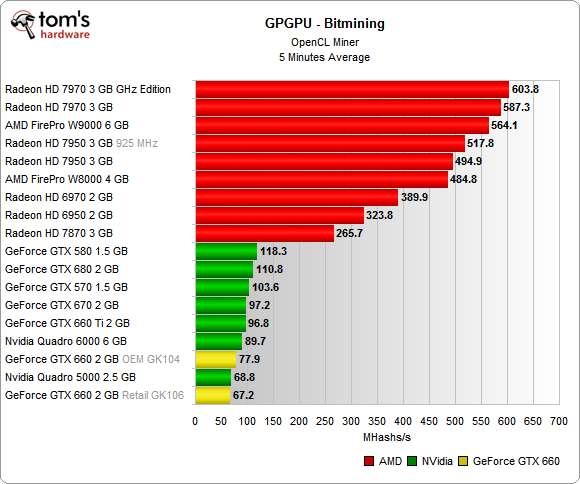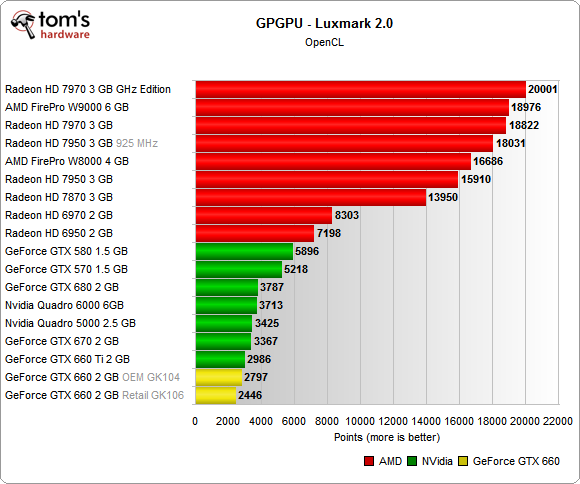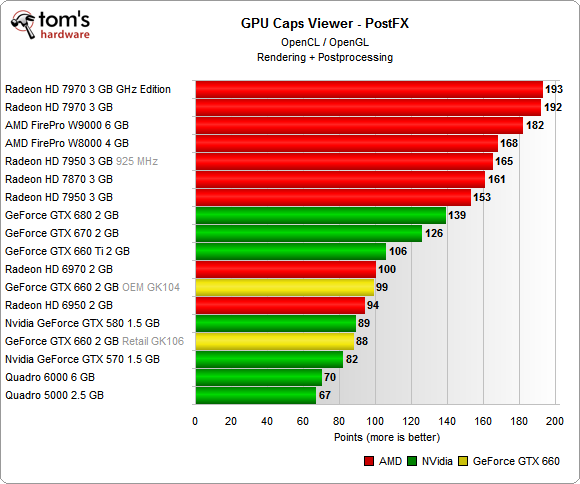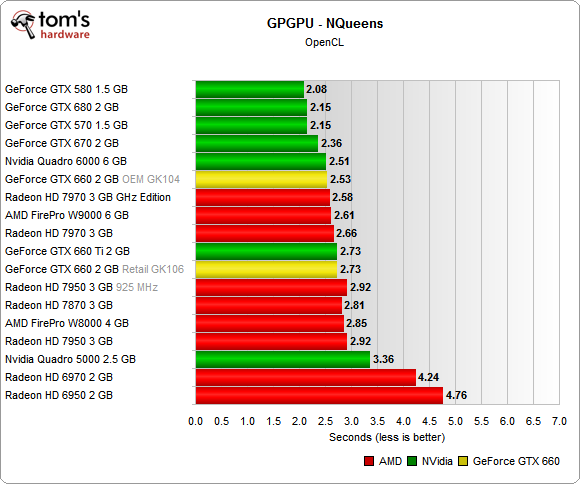Nvidia GeForce GTX 650 And 660 Review: Kepler At $110 And $230
We have two new graphics cards in the lab today: Nvidia's GeForce GTX 650 and 660, filling the gap between its GeForce GT 640 and GTX 660 Ti with Kepler derivatives. Are these GK107- and GK106-based boards able to challenge the Radeon HD 7750 and 7850?
OpenCL: GPGPU Benchmarks
In addition to including the current crop of workstation cards from both companies, we have the most important models from last generation. Depending on the OpenCL-enabled application, workload, and degree of driver optimization, we end up with varied results. Yet, we also see a distinct trend.
AMD’s workstation and consumer cards take a very clear lead in bitmining and SHA-256 hashing. If bitcoins are what you seek, the GeForce GTX 660 is not for you. In fact, the previous-gen GeForce GTX 580, sporting GF110, turns out to be the fastest Nvidia card in this field, serving as a reminder of how deliberately pared-down the compute resources of Kepler-based desktop cards really are.
We purposely chose LuxMark 2.0's simplest rendering workload for this test. Otherwise, Nvidia’s lower-end models would have given us even shorter bars, making them indiscernible. The previous-generation’s Fermi-based GeForce GTX 570 and 580 enjoy more pronounced leads as the scene's complexity increases. Once more, AMD’s entire line-up is completely out of any GeForce card’s reach.
The PostFX test utilizes both OpenCL and OpenGL to create one demanding workload. Although this benchmark comes straight from Nvidia’s SDK, it’s also an impressive example of how quickly the performance story can change in the face of a new architecture like GCN.
At last, Nvidia's Kepler family exhibits a stronger showing. Nonetheless, it's the company's previous-gen architecture that comes out on top once more. We're taken aback by the OEM version’s good results, since it even outpaces the GeForce GTX 660 Ti. Worried that this was a testing issue, we re-ran the benchmark several times and came up with consistent scores.
Get Tom's Hardware's best news and in-depth reviews, straight to your inbox.
Current page: OpenCL: GPGPU Benchmarks
Prev Page Memory Bandwidth: Analysis And Summary Next Page OpenCL: GPGPU Benchmarks (Basemark CL)Don Woligroski was a former senior hardware editor for Tom's Hardware. He has covered a wide range of PC hardware topics, including CPUs, GPUs, system building, and emerging technologies.
-
EDVINASM Was waiting for GTX 650 to see if it can beat the old GTX 550 Ti but it seems other than power draw it's no match. Might as well keep my GPU until next NVidia lineup. GTX 660 on other hand is only €50 cheaper than GTX 660 Ti meaning its a no budget saver to buy non Ti version. Fail...Reply -
mikenygmail Buy a 7770 or 7870 instead.Reply
Wait for sales on whichever one is needed and then grab one -
AMD 7770 can be had for just over $100.
AMD 7870 can be had for about $220. -
lahawzel Goddamn Mike NY Gmail or whatever the hell your name is supposed to be, here, proper commenting etiquette:Reply
1. Read the article.
2. Understand what the article is talking about.
3. If you find an urge to comment about "______ sucks" or "_______ wins again", especially when the article says the opposite of what you want to post, chances are your comment will look dumb as hell when it's posted and earn you 20 downvotes. Therefore, don't post that goddamn poor excuse of a "comment". -
tomfreak How "nice" of u tomshardware. By only compared 7750/7770 vs 650 in high detail but not comparing 7750/7770 on the Ultra detail, then when u pull out a 460 SE/9800GT for benchmark, u are taking away 650(why?).Reply
Is it because 650 performance is too poor to show off on benchmark? It doesnt take a genius to figure out the huge diff between 6870 vs 650. 7770= 6850 speed. So I guess even the 7750/460SE are putting shame on 650 on those high quality detail? too shy to show off 460SE/9800GT up against 650?
I dare u put on a detailed benchmark with 650 up against 7770/7750/GTS450/550ti/460/9800GT/9800GTX on all condition. Not a selective benchmark. -
Why are there giant gaps in both lineups? AMD has the 7770 at $130 and 7850 at $230 -- nvidia has the 650 and 660 at similar price points -- ideally for my budget would be something in the $150-170 price range, but I either have to compromise or shell out more. It seems like an obvious market gap.Reply
-
mikenygmail LaHawzelGod damn Mike NYThanks for the attempted compliment, but call me Mike. I'm glad you've been paying attention.Reply
It was more of a joke than anything else to simply write "AMD wins again!" and it was actually pretty funny! I try to balance things out so that no one company is viewed too favorably.
For example, I recently bought an Nvidia GTX 460 1 GB 256 bit card for $70, new, with a 3 month warranty for a friend to upgrade his gaming computer. Unusual? Yes. Great deal? You better believe it! Of course, if an equivalent AMD card was available at a cheaper price, that's the one I would've bought.
Now, relax and try to control yourself. Refrain from the use of profanity in future posts. Thanks.
-
EzioAs Nice article to be honest. I'm really glad you tested the Radeon cards with the new driver compared to other review sites.Reply
I've got nothing else to say on the GTX650 but to just point out that it's a weak card.
On the other hand, the GTX660 is probably the only Kepler (besides the 670) that impresses me. I don't know about everyone else though. To point out one thing, most Radeon 7870s can be found at $240 or lower without MIR. The GTX660 is priced well for a release MSRP and makes the 660ti offers less value, kind of like the 670 vs 680. For 8xMSAA, the performance does cripple but I think at this price point, most people are going to stay with 4xAA or possibly lower. -
mikenygmail EzioAsNice article to be honest. I'm really glad you tested the Radeon cards with the new driver compared to other review sites.I've got nothing else to say on the GTX650 but to just point out that it's a weak card.On the other hand, the GTX660 is probably the only Kepler (besides the 670) that impresses me. I don't know about everyone else though. To point out one thing, most Radeon 7870s can be found at $240 or lower without MIR. It's priced well for a release MSRP and makes the 660ti offers less value, kind of like the 670 vs 680. For 8xMSAA, the performance does cripple but I think at this price point, most people are going to stay with 4xAA or possibly lower.Reply
Exactly - Savvy TH readers will wait for sales on whichever one is needed and then grab one!
AMD 7770 can be had for just over $100 on sale.
AMD 7870 can be had for about $220 on sale.



